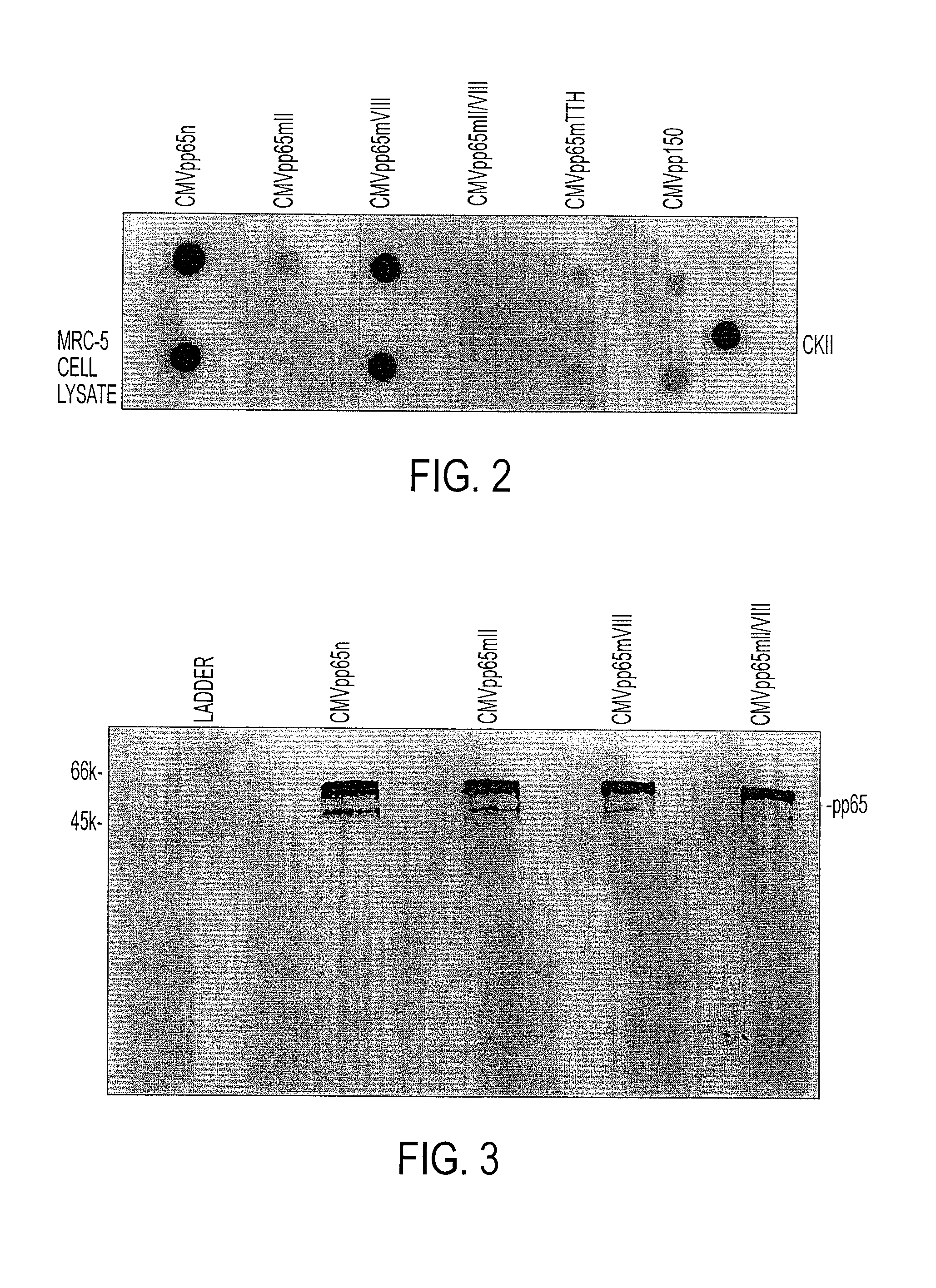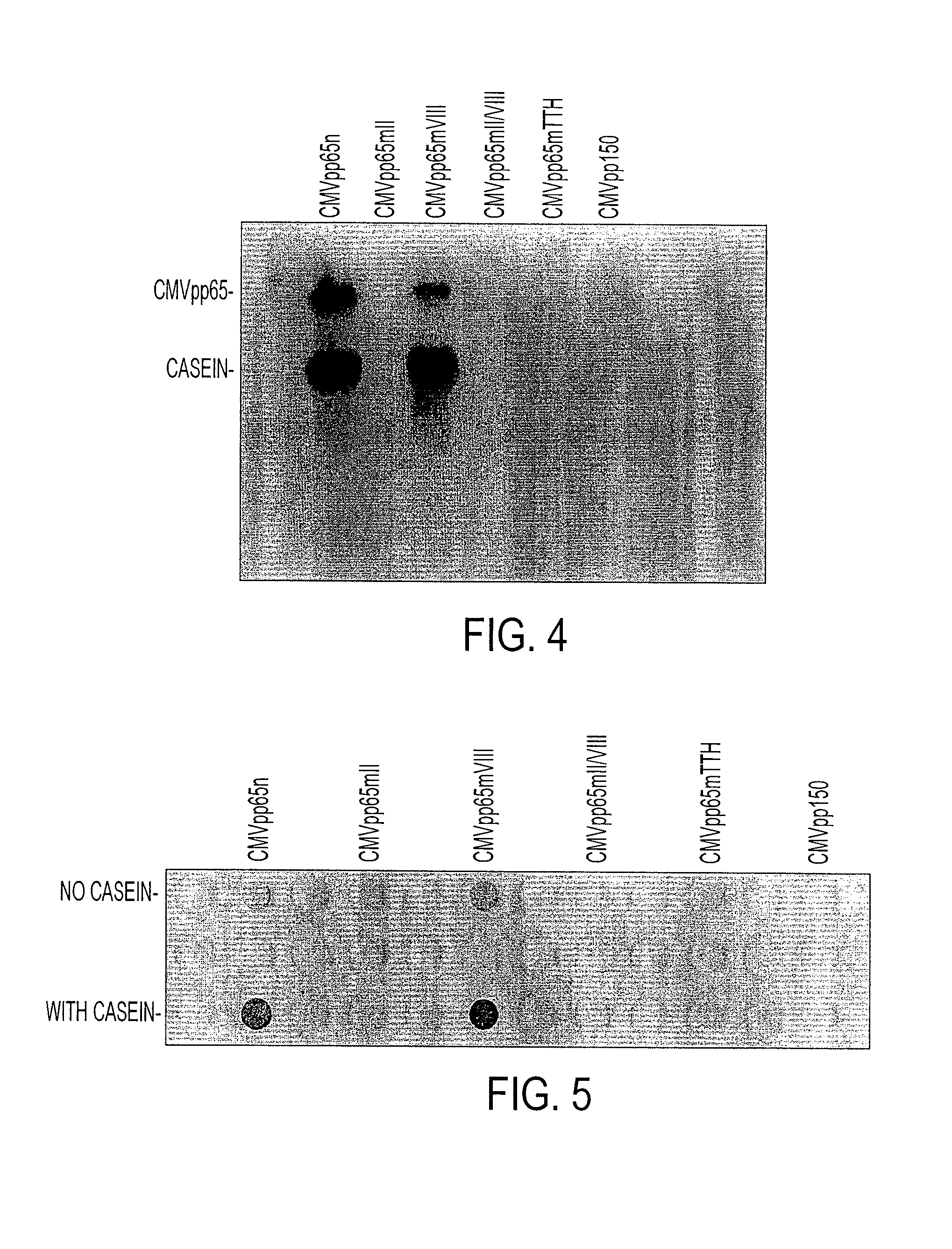Protein kinase deficient, immunologically active CMVpp65 mutants
a technology of protein kinase and immunological activity, which is applied in the field of protein kinase deficient, immunologically active cmvpp65 mutants, can solve the problems of limiting the use of intact cmvpp65 as a vaccine, presenting an unknown risk, and no such vaccine is currently commercially available, so as to enhance immunity to cytomegalovirus
- Summary
- Abstract
- Description
- Claims
- Application Information
AI Technical Summary
Benefits of technology
Problems solved by technology
Method used
Image
Examples
example 1
DNA Constructions and Generation of Recombinant Vaccinia Virus
[0047]The CMVpp65 gene, cloned into the BamHI and EcoRI restriction sites of pBluescript II KS DNA (35) was used to create the constructs. CMV nucleotide coordinates were used as published (4). Mutations of the CMVpp65 DNA were made using a Quikchange™ site-directed mutagenesis kit (Stratagene, San Diego, Calif.) using the following pairs of mutagenic primers developed using the published PK domain characteristics (22, 28). 5′ GCGGGCCGCAACCGCAAATCAGCATCC 3′ and 5′GGATGCTGATTTGCGGTTGCGGCCCGC 3′ (nt: 1270-1296; SEQ. ID NOS: 2 and 3) were used to mutate the indicated lysine into asparagine in the putative PK domain II (mII) of CMVpp65 (the K436N mutation). 5′ GAGTCCACCGTCGCGCCCAAAGAGGACACCGACGAG 3′ and 5′ CTCGTCGGTGTCCTCTTTGGGGGCGACGGTGGACTC 3′ (nt: 1345-1377; SEQ ID NOS: 4 and 5) were used to mutate the indicated glutamic acid into lysine in the putative PK domain VIII (mVIII) (the E465K mutation). The codon for the presume...
example 2
Immunoprecipitation of Recombinant CMVpp65
[0051]The CMVpp65 native and mutant proteins were expressed in the pQE9 bacterial system according to a Qiagenm™protocol. Cell pellets were extracted and subjected to immunoprecipitation as described by Michelson et al. (32) with modifications. Briefly, the bacterial pellets were frozen and thawed three times and incubated in lysis buffer (20 mN Tris / HCl pH 8.0, 300 mM NaCl, 10% glycerol, 2 mM EDTA, 0.5% Nonidet P-40) in the presence of protease inhibitor (5 μg / ml aprotinin and 5 μg / ml leupeptin) for 20 minutes at 40° C. The cell lysates were incubated with mouse IgG to remove nonspecific proteins, sonicated and then clarified by centrifugation at 15,000 x g for 5 minutes at 40° C. The CMVpp65 protein was immunoprecipitated with mAb28-103, specific for CMVpp65. Protein extract (200 μg) was mixed with 10 μl mAb28-103 unpurified ascites in 500 μl buffer A (10 mM TrisHCl, pH 7.4, 150 mN NaCl, 2 mN EDTA, 1% NP-40, with 5 μg / ml aprotinin and 5 μg...
example 3
[0052]The immunoprecipitated native and mutant CMVpp65 proteins, still bound to the sepharose beads, were tested for protein kinase (PK) activity. pQE9 pplS0 was also processed in the same way, as a negative control. Casein kinase II (Promega, Madison, Wis.) enzyme was used as a positive control. Dot blot PK assays were performed according to the methods of Glover and Allis (20). Briefly, 100 μl samples to be assayed were immobilized on a nitrocellulose membrane (Hybond ECL, Amersham Pharmacia Biotech, Piscataway, N.J.) by vacuum filtration using a commercial dot blot manifold (Minifold, Schleicher & Schuell, Inc.). Dephosphorylated bovine casein (Sigma Chemical Co, St Louis, Mich.) (100 μl 1 mg / ml) was added to each well as substrate, followed by incubation at room temperature for 30 minutes with 100 μl reaction mix (25 mM Tris pH 8.5, 100 mM NaCl, 10 mM MgCl2, 1 mM dithiothreitol, 0.1 μM [γ-32P]ATP). At the end of the incubation, free radioactive ATP was remov...
PUM
| Property | Measurement | Unit |
|---|---|---|
| pH | aaaaa | aaaaa |
| pH | aaaaa | aaaaa |
| concentration | aaaaa | aaaaa |
Abstract
Description
Claims
Application Information
 Login to View More
Login to View More - R&D
- Intellectual Property
- Life Sciences
- Materials
- Tech Scout
- Unparalleled Data Quality
- Higher Quality Content
- 60% Fewer Hallucinations
Browse by: Latest US Patents, China's latest patents, Technical Efficacy Thesaurus, Application Domain, Technology Topic, Popular Technical Reports.
© 2025 PatSnap. All rights reserved.Legal|Privacy policy|Modern Slavery Act Transparency Statement|Sitemap|About US| Contact US: help@patsnap.com



